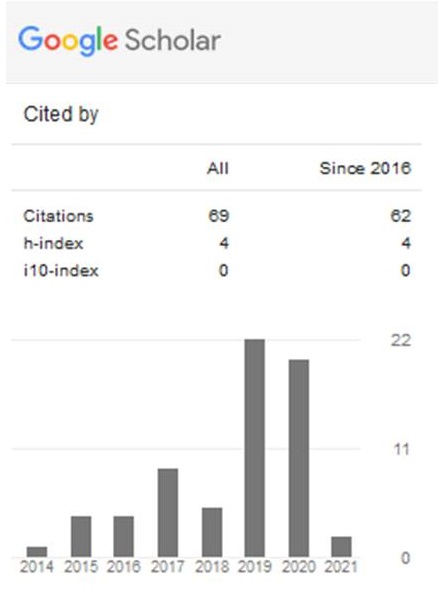Penggunaan Kombinasi Arang Batang Kelapa Sawit dan Pupuk N, P, dan K pada Tanaman Jagung Manis (Zea mays var.saccharata Sturt)
Abstract
This research aimed to study the effect of charcoal from oil palm trunks on soil chemical, growth and production of sweet corn, to study the effect of application N, P, K fertilizers on growth and production of sweet corn and combination of charcoal from oil palm trunks and application N, P, K fertilizers on growth and production of sweet corn. The experiment was arranged in a factorial trial using a completely randomized block design with three replicates. The first factors used the treatments in this experiment were : A0 (without charcoal), A1 (10 ton/ha), A2 (20 ton/ha), A3 (30 ton/ha), A4 ( 40 ton/ha), A5 (50 ton/ha). The second factors, were : P0 (without anorganinic fertilizers P1 (N = 75 kg/ha, P2O5 =15 kg/ha dan K2O=30 kg/ha), P2(N =150 kg/ha, P2O5 =30 kg/ha dan K2O =60 kg/ha). The results showed that application oil palm trunks can reach soil pH (5.10 to 6.64), C-Organic around 2.45-5.20%, N total 0.15-0.24%, K total around 25.15 –42.15 mg/g,available P (4.4 to 129.72 ppm) and soil cation exchange capacity (10.74 to32.31 me/100 g. Application of charcoal from oil palm trunks can improved plant height, number of leaves sweet corn, weight of cob, root-shoot ratio, lenght of cob and dry weight of plant. Application of N, P, K fertilizers can reach plant height, weight of cob and dry weight of plant. Combination of charcoal from oil palm trunks dosage 30 ton/ha and application N, P, K fertilizers (75:15:30) kg/ha can improved plant height and weight of cob and combination of charcoal from oil palm trunks dosage 50 ton/ha and application N, P, K fertilizers (75:15:30) kg/ha showed the heigest dry weight of plant.
Keywords
Full Text:
PDFReferences
Anonim. 1992. Sweet Corn Baby Corn. Jakarta: Penebar Swadaya.
Badan Pusat Statistik. 2014. Volume dan Nilai Impor Jagung Indonesia Tahun 2008-2012. BPS Indonesia.
Dariah, A., dan N.L. Nurida. 2002. Pemanfaatan Biochar Untuk Meningkatkan Produktivitas Lahan Kering Beriklim Kering. Badan Litbang Pertanian. Bogor.
Dinas Pertanian dan Peternakan. 2015. Buku Statistik Pertanian. Tanaman Pangan dan Hortikultura Tahun 2015. Pekanbaru
Direktorat Jenderal Hortikultura. 2014. Nilai Produksi Buah 2009-2012 Direktorat Jenderal Hortikultura. http://hortikultura.pertanian.go.id/index.php?option_com.contentandview=article&id=315&hemid=915. [17 Juni 2017]
Durieux, R.P., E.J. Kamprath., W.A. Jackson., and R.H. Moll. 1994. Root distribution of corn: the effect of nitrogen fertilization. Agron. 86: 530-534.
Febrianti. 2012. Peranan Arang Batang Kelapa Sawit Dalam Peningkatan Produksi Tanaman Jagung (Zea mays, L.). Tesis. Sekolah Pascasarjana. Institut Pertanian Bogor. Bogor.
Hardjowigeno, S. 2003. Ilmu Tanah. Akademika Pressindo. Jakarta.284 hal.
Hendaway, A.N.A., 2003. Influence of HNO3 Oxidation on The Srtucture and Adsorptive Properties of Corn Based activated Carbon. 41: 713-722. Elsevier.Uk.
Jones, J. B., B. Wolf., andH.A. Mills. 1991. Plant Analysis Handbook. Macro-Micro Publishing, Inc. Georgia.
Lahuddin. 1989. Pengaruh Abu Janjang Kelapa Sawit Terhadap B dan Zn-tersedia. Buletin Ilmu Pertanian USU. Medan. 8 hal
Lehmann, J., J. Gaunt., and M. Rondon. 2006. Biochar sequestration in terrestrial ecosystems. Review Journal of Migitation and adaptation Strategies for Global Change. 11:403-427 p
.
Marvelia, A., S. Damayanti dan S. Parman. 2006. Produksi tanaman jagung manis (Zea mays var. saccharata sturt.) yang diperlakukan dengan kompos kascing dengan dosis yang berbeda. Buletin Anatomi dan Fisiologi 16 (2): 7-18.
Nyakpa, M.Y., A.M. Lubis., M.A. Pulung., A.G. Amrah., A.Munawar., G.B.Hong., dan N. Hakim. 1988. Kesuburan Tanah. Universitas Lampung Press. Bandar Lampung.
Oussible, M., R.R. Allmaras., R.D. Wych., and R.K. Crookston. 1993. Sub-surface compaction effects on tillering and nitrogen accumulation in wheat. Agron. 85: 619-625.
Pari, G. 2004. Kajian Struktur Arang dari Serbuk Gergaji Kayu Sebagai Adsorben Formaldehide Kayu Lapis. Disertasi. Sekolah Pascasarjana. Institut Pertanian Bogor. Bogor.
Pusat Kajian Hortikultura Tropika. 2014. Konsumsi Buah Perkapita Hortikultura. Pusat Kajian Hortikultura Tropika. http://pkht.or.id/datastatistik/konsumsi/buah dan sayur. [17 Juni 2017]
Ran,Y., R. Habi., B. Baryosef., and A. Erez. 1994. Root volume effects on nitrogen uptake and partioning in peach trees. Agron. 86: 530-534
Rosmarkam, A., dan N.W.Yuwono. 2002. Ilmu Kesuburan Tanah. Kanisius.Yogyakarta.224 hal.
Standar Nasional Indonesia. 1995. Arang Aktif Teknis. SNI 06-3730-1995. Badan Standarisasi Nasional Indonesia. Jakarta.
Steiner, C., W.G. Teixeira., J. Lehmann., T. Nehl., J.L.V. de Macedo., W.E.H Blum., and W. Zech. 2007. Long term effect of manure, charcoal and mineral fertilization on crop production and fertility on highly weathered central amazonian up-land soil. Plant and Soil. 29 (1):275-290.
Sugiyanta. 2007. Peran Jerami dan Pupuk Hijau terhadap efisiensi dan Kecukupan Hara Lima Varietas Padi sawah. Disertasi. Sekolah Pascasarjana. Institut Pertanian Bogor. Bogor.
Syamsiah, S. 2008. Respon Tanaman Padi Gogo terhadap Stress Air dan Inokulasi Mikoriza. Skripsi. Fakultas Pertanian. Institut Pertanian Bogor.Bogor.
Triono, A. 2006. Karakteristik Briket Arang dari Campuran Serbuk Gergajian Kayu Afrika (Maesopsis eminii Engl) dan Sengon (Paraserianthes falcataria L. Nielsen) dengan Penambahan Tempurung Kelapa (Cocos mucifera L). Departemen Hasil Hutan. Fakultas Pertanian. Institut Pertanian Bogor. Bogor.
Widowati, Asnah dan Sutoyo. 2012. Pengaruh penggunaan biochar dan pupuk kalium terhadap pencucian dan serapan kalium pada tanaman jagung. Buana Sains. Jurnal Penelitian Ilmu-Ilmu kealaman.(12)1.
Winarso, S. 2005. Kesuburan Tanah Dasar Kesehatan dan Kualitas Tanah. Gava Media. Yogyakarta.
Refbacks
- There are currently no refbacks.

_2017.jpg)



